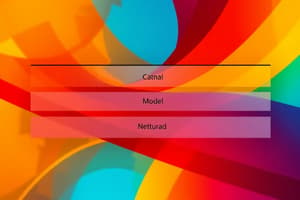Podcast
Questions and Answers
OSI मॉडल सीखने के क्या उद्देश्य हैं?
OSI मॉडल सीखने के क्या उद्देश्य हैं?
OSI मॉडल सीखने से नेटवर्क के कार्य और समस्याओं के समाधान में सुविधा होती है.
OSI मॉडल का मुख्य उपयोग क्या है?
OSI मॉडल का मुख्य उपयोग क्या है?
OSI मॉडल का मुख्य उपयोग नेटवर्किंग फ्रेमवर्क में प्रोटोकॉल को परिभाषित करने के लिए किया जाता है.
OSI मॉडल में कुल कितनी परतें होती हैं?
OSI मॉडल में कुल कितनी परतें होती हैं?
OSI मॉडल में कुल 7 परतें होती हैं.
OSI मॉडल के भौतिक परत का कार्य क्या है?
OSI मॉडल के भौतिक परत का कार्य क्या है?
ईथरनेट केबल्स और टोकन रिंग नेटवर्क किस OSI परत से संबंधित हैं?
ईथरनेट केबल्स और टोकन रिंग नेटवर्क किस OSI परत से संबंधित हैं?
OSI मॉडल को समझने से कंप्यूटर समस्याओं का समाधान कैसे आसान होता है?
OSI मॉडल को समझने से कंप्यूटर समस्याओं का समाधान कैसे आसान होता है?
MAC पता क्या है और इसका OSI मॉडल में क्या महत्व है?
MAC पता क्या है और इसका OSI मॉडल में क्या महत्व है?
ARP का महत्व OSI मॉडल में क्या है?
ARP का महत्व OSI मॉडल में क्या है?
कंप्यूटर कैसे जानता है कि इंटरनेट वेब सर्वर तक पहुंचने के लिए डिफ़ॉल्ट गेटवे का भौतिक MAC पता क्या है?
कंप्यूटर कैसे जानता है कि इंटरनेट वेब सर्वर तक पहुंचने के लिए डिफ़ॉल्ट गेटवे का भौतिक MAC पता क्या है?
डेटा लिंक परत में वेब अनुरोध को कैसे संभाला जाता है?
डेटा लिंक परत में वेब अनुरोध को कैसे संभाला जाता है?
फिजिकल लेयर की भूमिका क्या है जब वेब पृष्ठ अनुरोध को डिफ़ॉल्ट गेटवे तक पहुंचाना होता है?
फिजिकल लेयर की भूमिका क्या है जब वेब पृष्ठ अनुरोध को डिफ़ॉल्ट गेटवे तक पहुंचाना होता है?
OSI मॉडल की परतें एक-दूसरे के साथ कैसे संवाद करती हैं?
OSI मॉडल की परतें एक-दूसरे के साथ कैसे संवाद करती हैं?
कंप्यूटर अपने लौटने वाले IP पते को वेब सर्वर के लिए संदेश में कैसे शामिल करता है?
कंप्यूटर अपने लौटने वाले IP पते को वेब सर्वर के लिए संदेश में कैसे शामिल करता है?
प्रस्तुति परत का मुख्य कार्य क्या है?
प्रस्तुति परत का मुख्य कार्य क्या है?
एप्लीकेशन परत की भूमिका क्या है?
एप्लीकेशन परत की भूमिका क्या है?
HTTP प्रोटोकॉल का उपयोग किस परत में किया जाता है?
HTTP प्रोटोकॉल का उपयोग किस परत में किया जाता है?
एक वेब ब्राउज़र का कार्य क्या है?
एक वेब ब्राउज़र का कार्य क्या है?
प्रस्तुति परत द्वारा कौन-सी प्रक्रिया की जाती है?
प्रस्तुति परत द्वारा कौन-सी प्रक्रिया की जाती है?
ओएसआई मॉडल में स्थानीय क्षेत्र नेटवर्क का उदाहरण किस परत पर संबंधित है?
ओएसआई मॉडल में स्थानीय क्षेत्र नेटवर्क का उदाहरण किस परत पर संबंधित है?
एप्लीकेशन परत का कौन सा कार्य महत्वपूर्ण माना जाता है?
एप्लीकेशन परत का कौन सा कार्य महत्वपूर्ण माना जाता है?
क्या प्रस्तुतियाँ एन्क्रिप्शन और डीक्रिप्शन प्रक्रिया को संभालती हैं?
क्या प्रस्तुतियाँ एन्क्रिप्शन और डीक्रिप्शन प्रक्रिया को संभालती हैं?
भौतिक परत में डेटा कैसे प्रसारित किया जाता है?
भौतिक परत में डेटा कैसे प्रसारित किया जाता है?
डेटा लिंक परत की मुख्य भूमिका क्या है?
डेटा लिंक परत की मुख्य भूमिका क्या है?
नेटवर्क परत में डेटा के साथ क्या होता है?
नेटवर्क परत में डेटा के साथ क्या होता है?
ट्रांसपोर्ट परत का मुख्य कार्य क्या है?
ट्रांसपोर्ट परत का मुख्य कार्य क्या है?
सेशन परत किस प्रकार के कनेक्शन का प्रबंधन करती है?
सेशन परत किस प्रकार के कनेक्शन का प्रबंधन करती है?
मीडिया एक्सेस कंट्रोल उपपरत का कार्य क्या है?
मीडिया एक्सेस कंट्रोल उपपरत का कार्य क्या है?
लॉजिकल लिंक कंट्रोल उपपरत का क्या महत्व है?
लॉजिकल लिंक कंट्रोल उपपरत का क्या महत्व है?
IP नेटवर्किंग में भौतिक और तार्किक पते के बीच किस प्रोटोकॉल का उपयोग किया जाता है?
IP नेटवर्किंग में भौतिक और तार्किक पते के बीच किस प्रोटोकॉल का उपयोग किया जाता है?
PRESENTATION लेयर का मुख्य कार्य क्या है?
PRESENTATION लेयर का मुख्य कार्य क्या है?
HTTP अनुरोध के दौरान वेब ब्राउज़र क्या करता है?
HTTP अनुरोध के दौरान वेब ब्राउज़र क्या करता है?
TCP कनेक्शन का कार्य क्या है?
TCP कनेक्शन का कार्य क्या है?
HTML टैग का वेब पेज में क्या महत्व है?
HTML टैग का वेब पेज में क्या महत्व है?
नेटवर्क लेयर में Internet Protocol (IP) का क्या कार्य है?
नेटवर्क लेयर में Internet Protocol (IP) का क्या कार्य है?
SESSION की परिभाषा क्या है?
SESSION की परिभाषा क्या है?
वेब ब्राउज़र अतिरिक्त TCP कनेक्शन क्यों खोलता है?
वेब ब्राउज़र अतिरिक्त TCP कनेक्शन क्यों खोलता है?
PRESENTATION लेयर की भूमिका में कौन सी अन्य फाइलें शामिल हो सकती हैं?
PRESENTATION लेयर की भूमिका में कौन सी अन्य फाइलें शामिल हो सकती हैं?
Flashcards
OSI Model Purpose
OSI Model Purpose
The OSI model helps understand how network functions work and interact.
OSI Model Function
OSI Model Function
The OSI Model logically divides network architecture into 7 layers, enabling layered protocol implementation.
OSI Model Layers
OSI Model Layers
The OSI Model divides the network into 7 layers, each responsible for specific networking tasks.
Physical Layer
Physical Layer
Signup and view all the flashcards
Network Devices
Network Devices
Signup and view all the flashcards
Troubleshooting
Troubleshooting
Signup and view all the flashcards
Network Architecture
Network Architecture
Signup and view all the flashcards
OSI Model Use
OSI Model Use
Signup and view all the flashcards
Physical Layer
Physical Layer
Signup and view all the flashcards
Data Link Layer
Data Link Layer
Signup and view all the flashcards
Network Layer
Network Layer
Signup and view all the flashcards
Transport Layer
Transport Layer
Signup and view all the flashcards
Session Layer
Session Layer
Signup and view all the flashcards
MAC Address
MAC Address
Signup and view all the flashcards
IP Address
IP Address
Signup and view all the flashcards
Data Frames
Data Frames
Signup and view all the flashcards
Application Layer Function
Application Layer Function
Signup and view all the flashcards
Presentation Layer Function
Presentation Layer Function
Signup and view all the flashcards
Web Browser Role
Web Browser Role
Signup and view all the flashcards
HTTP Protocol
HTTP Protocol
Signup and view all the flashcards
OSI Model Layer 7
OSI Model Layer 7
Signup and view all the flashcards
Web Server Interaction
Web Server Interaction
Signup and view all the flashcards
Presentation Layer Simplicity
Presentation Layer Simplicity
Signup and view all the flashcards
Application Layer to Presentation layer interaction
Application Layer to Presentation layer interaction
Signup and view all the flashcards
Presentation Layer
Presentation Layer
Signup and view all the flashcards
HTTP and Session
HTTP and Session
Signup and view all the flashcards
TCP Connection
TCP Connection
Signup and view all the flashcards
Transport Layer
Transport Layer
Signup and view all the flashcards
Internet Protocol (IP)
Internet Protocol (IP)
Signup and view all the flashcards
Web Server
Web Server
Signup and view all the flashcards
Web Browser
Web Browser
Signup and view all the flashcards
HTML tags
HTML tags
Signup and view all the flashcards
IP Protocol
IP Protocol
Signup and view all the flashcards
ARP (Address Resolution Protocol)
ARP (Address Resolution Protocol)
Signup and view all the flashcards
Default Gateway
Default Gateway
Signup and view all the flashcards
MAC Address
MAC Address
Signup and view all the flashcards
Data Link Layer
Data Link Layer
Signup and view all the flashcards
Study Notes
Why Learn the OSI Model?
- Understanding how web browsers work
- Understanding how Internet Protocol (IP) and Address Resolution Protocol (ARP) operate
- Understanding the function of MAC addresses
- Facilitating easier learning and troubleshooting of computer problems
- Easier communication with other technical personnel
OSI Model Layers
- A networking architecture based on the OSI model
- Seven layered structure for network communication
- Layers work together for data transmission
- Each layer handles specific tasks, with data passing between layers
- Divides network architecture logically for easy learning
- Layers 1–3 deal with lower-level functions (electrical signals, data routing)
- Layers 4–7 deal with user-level network requests and data representation
Physical Layer
- Responsible for ultimate digital data transmission between devices
- Uses various technologies (Ethernet, Token Ring, etc.) and physical media (cables, etc.)
- Deals with signaling types (electric, radio, infrared, light) in the medium
- First step in data transmission, converting data into bits
Data Link Layer (Layer 2)
- Checks for transmission errors
- Packages bits into frames
- Manages physical addressing (MAC addresses) for devices
- Controls access by devices to the physical medium
- Has two sub-layers to manage access to the physical network medium and logical link control
Network Layer (Layer 3)
- Handles routing (data delivery to the destination)
- Uses logical addresses (e.g., IP addresses)
- Maps logical addresses to physical ones (e.g., ARP)
- Formats data into packets, sending them up to the transport layer
Transport Layer (Layer 4)
- Provides data transport across network connections
- TCP (Transmission Control Protocol) is among the common transport layer protocols
- Handles important functions like error recovery, flow control, and retransmission
Session Layer (Layer 5)
- Manages how network connections are established and terminated, supporting multiple connections
- Sequence and flow of events during network connections
- Handles dynamic connections in multiple networks
Presentation Layer (Layer 6)
- Simple layer
- Deals with data syntax operations like format conversion, encryption, and decryption
- Takes data from application layer, formats it, and puts it onto the network
- Handles interactions between different kinds of applications or systems
Application Layer (Layer 7)
- Supplies network services to user applications
- Contains protocols for user activities like web browsing etc. (e.g., HTTP)
- Interfaces directly with end-user applications
Studying That Suits You
Use AI to generate personalized quizzes and flashcards to suit your learning preferences.



